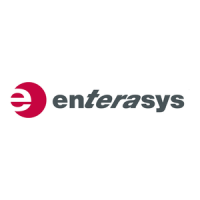Enterasys S-Series S8 Chassis Hardware Installation Guide B-1
B
About PoE (Power over Ethernet)
ThisappendixprovidesanoverviewofPoweroverEthernettechnologyandhowitis
implementedinrelationtotheS‐Seriesdevices.
Overview
PoweroverEthernet(PoE)referstotheabilitytoprovideoperationalpowerthroughthesame
EthernetcablingtoaPD(powereddevice)connectedtoadatanetwork.ModernEthernet
implementationsemploydifferentialsignalsovertwistedpaircables.Thisrequiresaminimumof
twotwistedpairsforasinglephysicallink.Both
endsofthe cab leareisolatedwithtransformers
blockinganyDCorcommonmodevoltageonthesignalpair.PoEexploitsthisfactbyusingtwo
twistedpairsasthetwoconductorstosupplyadirectcurrent.Onepaircarriesthepowersupply
currentandtheotherpairprovidesa
pathforthereturncurrent.Whileseveralproprietarylegacy
implementationsofPoEhavebeendeployedbyLANequipmentvendors,in2003theIEEE
publishedtheIEEE802.3af‐2003specification,whichispartofthe802.3suiteofstandards.
TheS‐SerieschassisthatsupportPoEarefullycompliantwiththeIEEE
802.3afand802.3at
standards.Theysupportthestandardresistor‐baseddetectionmethod,aswellasACdisconnect
capability.
EachPDhasaPDC(PoweredDeviceClassification)thatistransmittedtotheS‐Serieschassisfor
powermanagementpurposes.Table B‐1liststheclassificationsandtheassociatedpowerranges
basedonthe
802.3afstandard.Thistablewillbeupdatedwith802.3atclassinformationwhenthe
802.3atdraftisratified.
Proprietary PD Detection
S‐SeriesdevicessupportasubsetofthecurrentlydeployedproprietaryPoEmethods.This
includessupportforCiscoPDs,includingaproprietarycapacitorbaseddetectionscheme.
Table B-1 Powered Device Classifications
Class Usage PD Maximum Power Range Usage
0 Default 0.44 to 12.95 Watts
1 Optional 0.44 to 3.84 Watts
2 Optional 3.84 to 6.49 Watts
3 Optional 6.49 to 12.95 Watts
4 Not Allowed Reserved for Future Use

